What Is Sui: The Core Basics Explained
- BLOG
- Blockchain
- November 24, 2025
You’ve seen the hype. New games, DeFi apps, and digital experiences claim to run smoother on Sui than on any other chain. That might push you to ask what is Sui and why so many builders are pivoting toward it right now.
The truth is simple: most blockchains struggle the moment real activity hits. Sui was engineered to fix that. Its architecture lets assets evolve, transactions settle fast, and applications scale without collapsing under pressure.
If you want to build products that feel responsive and future-ready, Sui is a network you can’t ignore. And if you want to know more about Sui, this guide covers everything you need.
Contents
- 1 What Is Sui?
- 2 How Sui Works: Key Architecture Explained
- 3 The Core Problems Sui Addresses in Blockchain Design
- 4 Key Features and Use Cases of the Sui Network
- 5 Build powerful Sui applications with Webisoft’s expert team!
- 6 SUI Token: Utility, Tokenomics, and Governance
- 7 How Sui Compares to Other Layer 1 Blockchains
- 8 Sui Adoption and Ecosystem Growth
- 9 Why Businesses and Developers Choose Sui
- 10 How Webisoft Simplifies Sui Blockchain Development
- 11 Build powerful Sui applications with Webisoft’s expert team!
- 12 Conclusion
- 13 Frequently Asked Question
What Is Sui?
Sui is a next-generation Layer 1 blockchain platform developed by Mysten Labs, a team of engineers who previously worked on Meta’s Diem project. Many people exploring what is Sui crypto are trying to understand why Sui is seen as a major step forward compared to traditional chains. This isn’t just another blockchain aiming for marginal improvement.
Sui is designed with a fresh architecture and a developer-first mindset. It introduces a new way to represent digital assets, process transactions, and build decentralized applications (dApps) that need high performance and low latency.
When you engage with Sui, the native token is SUI, which plays key roles in staking, governance, and network utility. (More on that in later sections.) The network launched in May 2023 and quickly gathered momentum.
For you as a builder, project leader, or investor, Sui offers a platform purpose-built to handle demanding applications. Not just simple token transfers or basic smart contracts.
How Sui Works: Key Architecture Explained
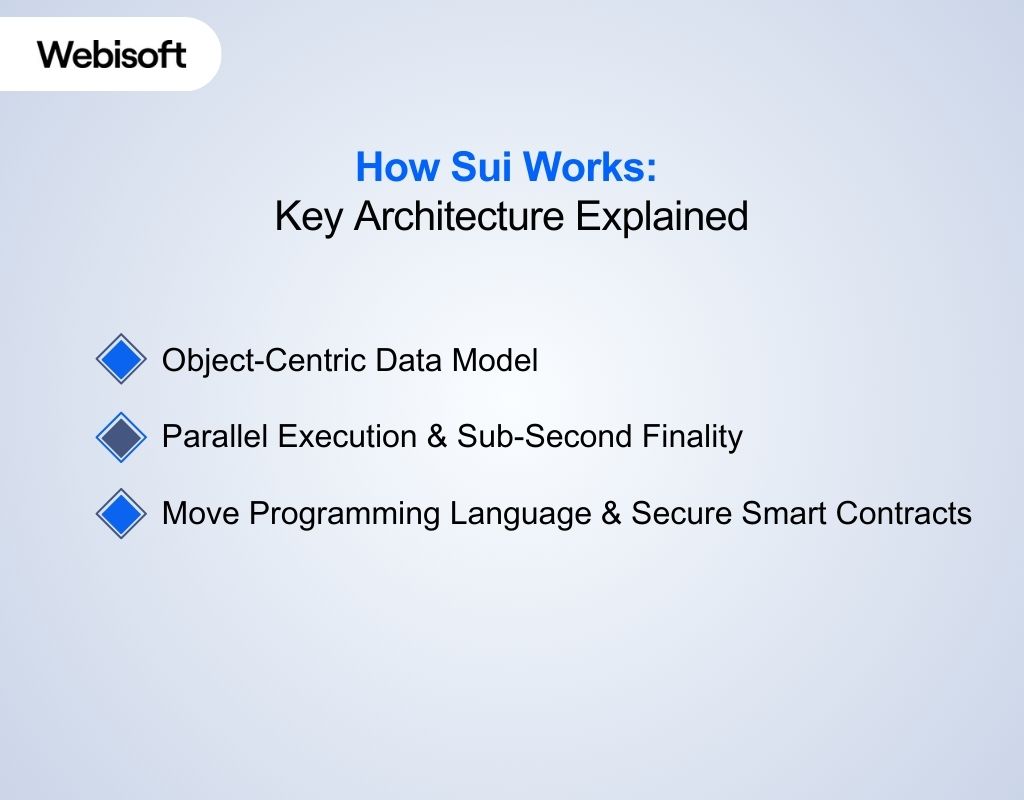 To understand what sets Sui apart, you need to look under the hood and the Sui official documentation provides deeper insights into how its architecture is structured. Its design helps clarify what is Sui Web 3 by showing how Sui reshapes asset ownership, execution, and data handling in a decentralized environment.
To understand what sets Sui apart, you need to look under the hood and the Sui official documentation provides deeper insights into how its architecture is structured. Its design helps clarify what is Sui Web 3 by showing how Sui reshapes asset ownership, execution, and data handling in a decentralized environment.
Object-Centric Data Model
Traditional blockchains use an account-based model: assets, balances, and smart contract states are tracked by accounts. Sui flips this model on its head. Instead of being tied to accounts, every asset on Sui is treated as an object: tokens, NFTs, game items, even contracts themselves.
Because each object is discrete and has clear ownership, many transactions can operate independently. When you transact with objects that don’t overlap (i.e., touch different assets), those operations can be processed in parallel. This design is key to Sui’s scalability.
Parallel Execution & Sub-Second Finality
Many blockchains are still bottlenecked by sequential transaction processing. Sui avoids this by enabling parallel execution of transactions. If you initiate multiple independent operations, they can proceed simultaneously instead of queuing.
Sui also uses efficient consensus mechanisms (including Narwhal & Bullshark, and later upgrades) that shorten finality time. The result? Transactions settle with very low latency. For you, that means apps built on Sui feel responsive and capable of handling high throughput scenarios, whether real-time gaming, large-scale DeFi, or NFT platforms.
Move Programming Language & Secure Smart Contracts
Sui uses the Move programming language, originally developed for the Diem project. Move is resource-oriented: it treats digital assets as first-class resources, which helps prevent vulnerabilities like asset duplication or unintended leaks.
In Sui’s case, Move enables developers to build contracts and assets with security and composability in mind, reducing common risks. That means less boilerplate shimming for safety, and more confidence in deploying asset-rich applications.
Building on Sui and ready to move forward? Webisoft helps you design secure, high-performance Sui applications using Move, dynamic assets, and scalable architecture. Contact Webisoft now and start bringing your Sui project to life.
The Core Problems Sui Addresses in Blockchain Design
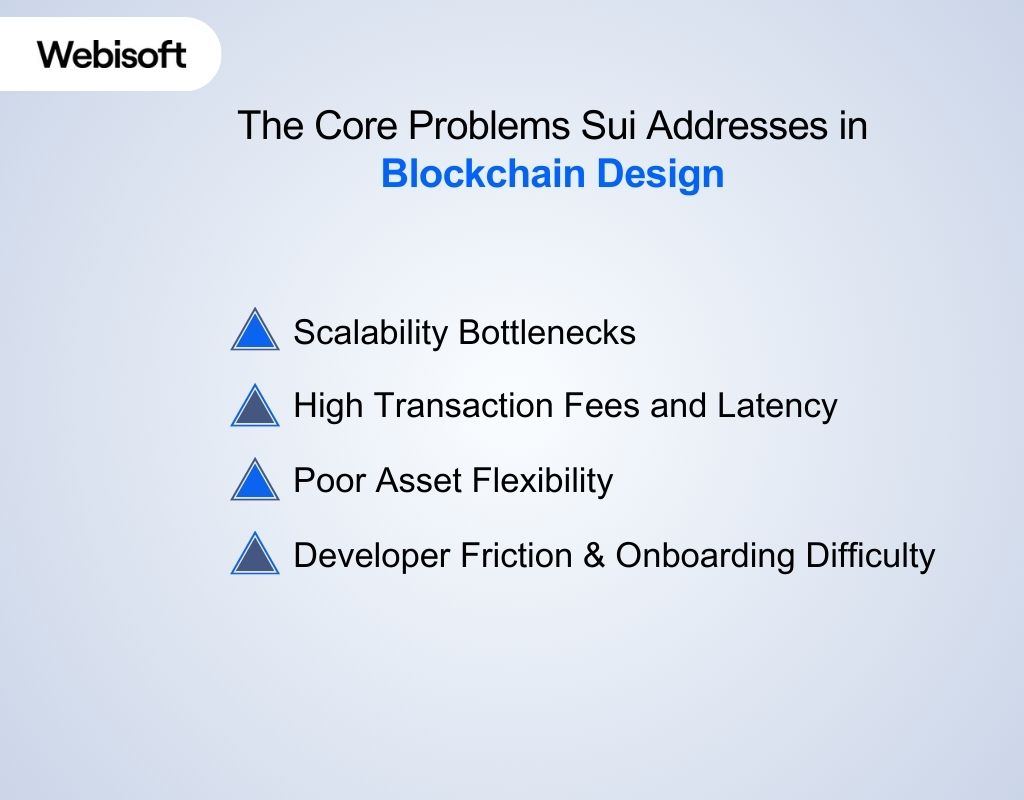 When you examine existing Layer 1 blockchains, several recurring pain points emerge. Understanding these issues gives you an idea of what is Sui network in practical terms, and why its architecture solves problems that slow down other chains.
When you examine existing Layer 1 blockchains, several recurring pain points emerge. Understanding these issues gives you an idea of what is Sui network in practical terms, and why its architecture solves problems that slow down other chains.
Scalability Bottlenecks
Many blockchains struggle when usage increases: fees rise, latency grows, and throughput drops. Sui’s object model plus parallel execution directly addresses this. Because transactions touching different objects don’t conflict, they don’t queue up. For your project, this translates into a network that can scale with usage instead of throttling it.
High Transaction Fees and Latency
When network congestion occurs, gas fees go up and user experience suffers. Sui’s architecture aims for low fees and near-instant confirmation by avoiding global state bottlenecks. If you’re building an application where users expect experiences comparable to Web 2 apps, whether games, peer-to-peer payments, or DeFi, Sui offers a more user-friendly path.
Poor Asset Flexibility
Traditional smart contracts and asset models often treat NFTs or tokens as static. But many modern use cases require assets that evolve, are combined, or change state (e.g., game items that level up). Sui’s object-centric model permits dynamic asset types with rich behaviours. This gives you the freedom to build more advanced interactive experiences, not just static token transfers.
Developer Friction & Onboarding Difficulty
For new users, managing wallets, paying fees, and writing secure contracts remain obstacles. Sui improves onboarding through tools and features like zero-knowledge login, while its architecture supports straightforward logic that helps you create applications with reduced friction overall.
As someone building or planning, that means fewer roadblocks and more potential to reach mainstream users, particularly when backed by structured guidance through Blockchain Consulting Services.
Key Features and Use Cases of the Sui Network
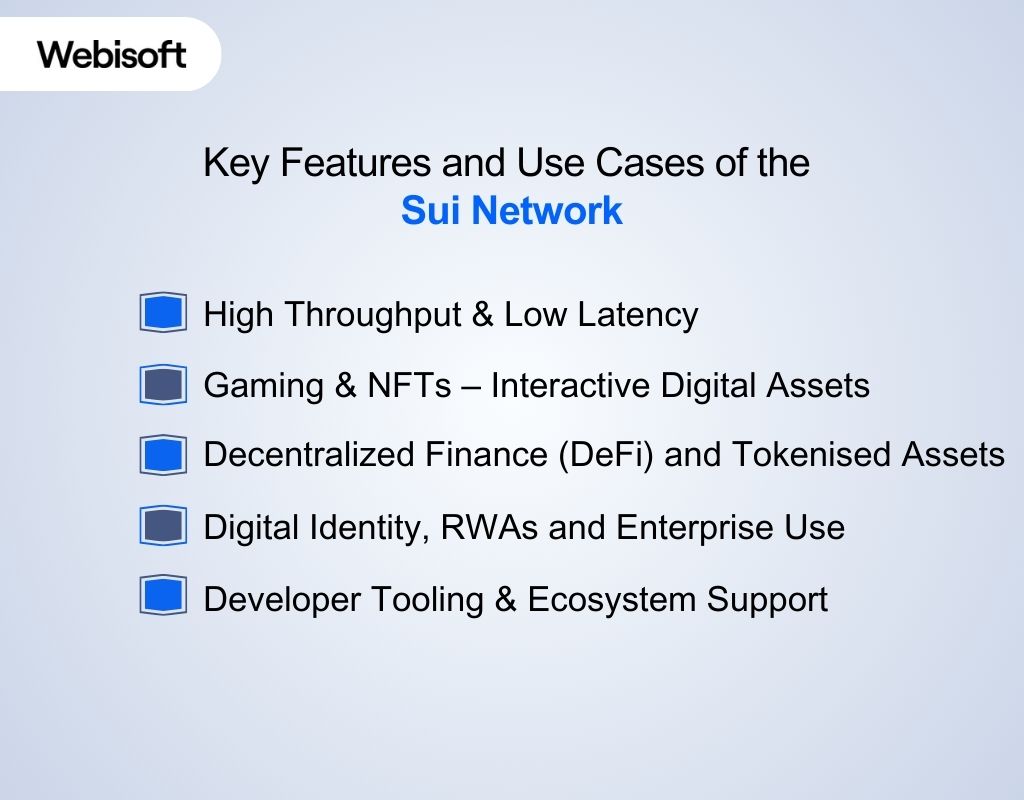 Now that you understand what Sui is and why it was constructed, it becomes easier to see what is Sui blockchain in action. These features show how Sui supports interactive assets, high-throughput activity, and modern, scalable applications.
Now that you understand what Sui is and why it was constructed, it becomes easier to see what is Sui blockchain in action. These features show how Sui supports interactive assets, high-throughput activity, and modern, scalable applications.
High Throughput & Low Latency
Thanks to its architectural design, Sui is able to process large numbers of transactions concurrently while keeping latency low. Some sources report thousands of TPS in testing and very fast confirmation times. If you’re building real-time applications, such as gaming or high-frequency trades, these capabilities provide a strong foundation.
Gaming & NFTs – Interactive Digital Assets
Because Sui treats each asset as an object, game items, NFTs, and other interactive assets are first-class citizens. For example, you could build a game where items evolve, merge, or upgrade on-chain, without hitting the congestion traps of older chains. This appeals to creators, game studios, and brands looking to tokenize items or build immersive Web3 experiences.
Decentralized Finance (DeFi) and Tokenised Assets
Sui supports DeFi applications such as lending, staking, swapping, governance tokens, and synthetic assets. The low fee, scalable environment makes this viable for large-scale financial systems.
If you’re planning a token launch, liquidity platform, or complex financial smart-contract system, Sui provides an architecture capable of supporting it.
Digital Identity, Real-World Assets (RWAs) and Enterprise Use
The object model and secure contract environment also make Sui suitable for enterprise use-cases: supply-chain tracking, digital identity, real-world asset tokenisation.
The ability to update on-chain objects dynamically supports ongoing state changes required by business logic. If your business wants to move beyond consumer apps and into enterprise-grade infrastructure, this versatility is a major advantage.
Developer Tooling & Ecosystem Support
Sui provides SDKs, documentation, and uses the Move language which is resource-secure. Developer experience is a major focus. If you are a developer assessing chains, the ease of tooling, documentation and community support matters and Sui delivers on that front.
Build powerful Sui applications with Webisoft’s expert team!
Start your Sui project with secure architecture and high-performance development support
SUI Token: Utility, Tokenomics, and Governance
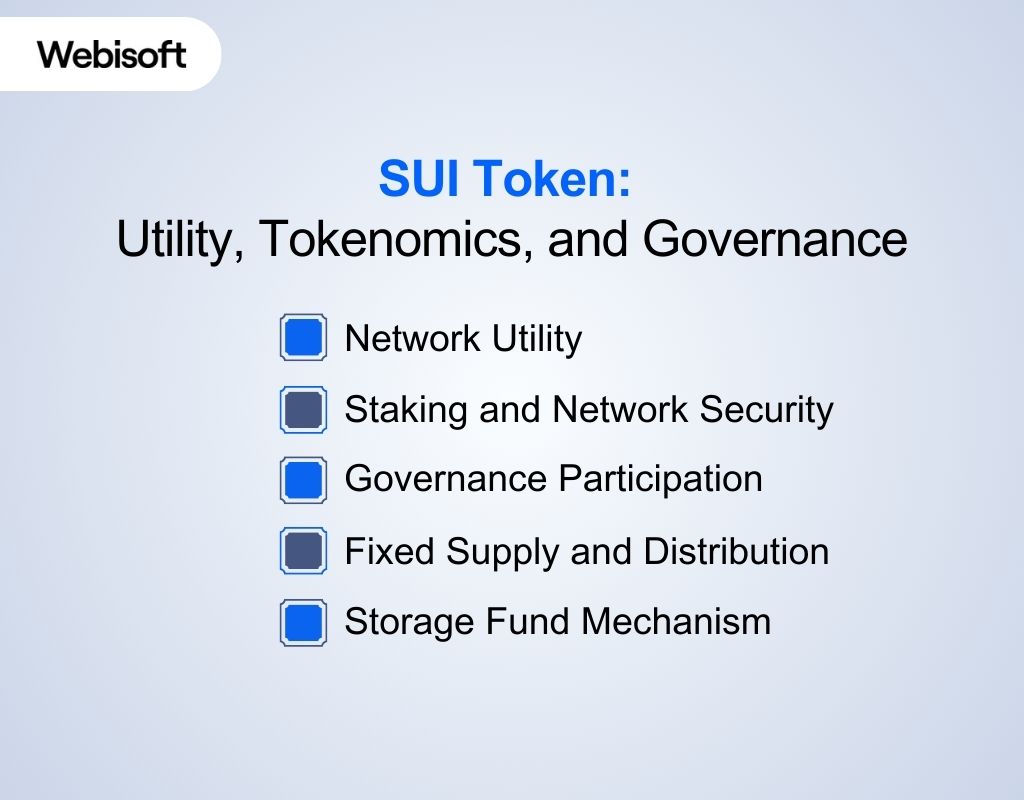 Before you explore Sui’s technical design, it helps to understand how the SUI token supports the network. The token shapes fees, staking, governance, and long-term system behaviour. Each part influences how you build and operate on the platform.
Before you explore Sui’s technical design, it helps to understand how the SUI token supports the network. The token shapes fees, staking, governance, and long-term system behaviour. Each part influences how you build and operate on the platform.
Network Utility
SUI is the primary medium for paying gas, computation, and storage fees. Every time you modify an object, publish a module, or execute contract logic, the transaction uses SUI to settle costs. Sui separates computation from long-term storage, which allows fees to remain predictable even when network activity increases. This structure helps you estimate operational expenses when planning application growth.
Staking and Network Security
The network operates on a delegated Proof of Stake system. You can stake SUI directly or delegate it to a validator of your choice. Validators process transactions, maintain system integrity, and compete based on performance.
Rewards are distributed to validators and their delegators each epoch. This design encourages long-term participation and builds a stable security model. As a builder, staking also gives you a clear incentive path for supporting the network that hosts your application.
Governance Participation
SUI holders play a role in shaping the network over time. Governance covers key parameters such as validator policies, economic settings, and technical upgrades. If you hold SUI, you gain voting power that influences the decisions affecting throughput, cost structure, and validator economics. This system promotes active oversight and ensures that long-term participants guide the network’s evolution.
Fixed Supply and Distribution
SUI has a capped supply of ten billion tokens. This limit prevents unchecked inflation and aligns token value with actual network participation. Distribution spans several groups: community and ecosystem support, core contributors, early backers, and long-term reserves.
Each category exists to support a specific aspect of Sui’s growth. This structure offers transparency and avoids abrupt shifts in circulating supply, which can affect project planning.
Storage Fund Mechanism
Sui uses a unique storage fund to manage long-term data responsibilities. When you store data on-chain, part of your fee enters this fund. Future validators receive compensation from it to maintain the stored objects.
This system reduces the risk that long-lived applications become more expensive to maintain over time. It ties validator rewards to real usage and helps ensure that storage-heavy applications remain sustainable.
How Sui Compares to Other Layer 1 Blockchains
When you evaluate a blockchain for development, comparison is essential. This table shows how Sui differs from other major Layer 1 networks and where it fits within your project goals.
| Category | Sui | Typical Layer 1 Chains (Ethereum, Solana, Avalanche, Aptos) |
| Execution Model | Uses causal ordering and parallel execution. Independent transactions run at the same time without conflict. | Most rely on sequential global ordering. Many transactions queue and compete for block space. |
| Data Model | Object-centric model. Assets exist as independent objects with clear ownership. | Account-based model. Balances and states tied to accounts, increasing global state contention. |
| Performance Profile | Predictable low latency and high throughput even under load. Early metrics show strong growth in activity and TVL. | Performance varies by chain. Many face congestion, higher fees, or execution bottlenecks during peak usage. |
| Developer Experience | Uses Move language. Asset rules are secure by design. Ownership logic simpler to enforce. | Solidity or Rust ecosystems often require extra safeguards to prevent asset duplication or loss. |
| Ecosystem Maturity | Newer ecosystem growing quickly through grants, tooling, hackathons, and rising user activity. | Older networks offer deeper liquidity, longer histories, and more established integration layers. |
| Best Fit For | High-interaction apps needing fast settlement, dynamic assets, and predictable throughput. | Apps prioritizing liquidity, existing user bases, or legacy ecosystem support. |
Sui Adoption and Ecosystem Growth
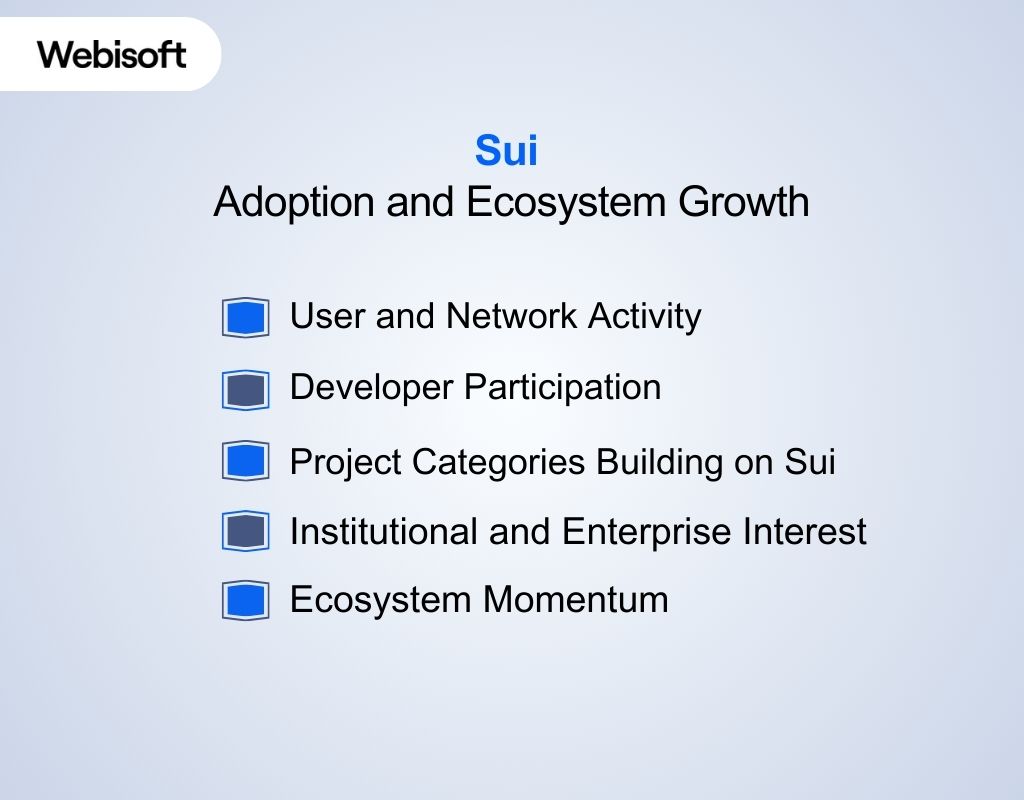 Adoption signals real traction in any blockchain ecosystem. If you plan to build or scale on Sui, you need to know whether the network is active, growing, and supported by both users and developers.
Adoption signals real traction in any blockchain ecosystem. If you plan to build or scale on Sui, you need to know whether the network is active, growing, and supported by both users and developers.
User and Network Activity
Daily users continue growing. The network processes heavy activity while maintaining stable performance, helping interactive applications operate without delay.
Developer Participation
The ecosystem includes SDKs, documentation, and active learning resources. Grants, tutorials, and builder support draw more developers into the network.
Project Categories Building on Sui
Teams deploy applications in gaming, NFTs, DeFi, and infrastructure. Many projects use dynamic assets because Sui handles object updates efficiently.
Institutional and Enterprise Interest
Sui’s partnerships with custodians, exchanges, and tooling providers support institutional use. Trading activity and liquidity levels have also grown.
Ecosystem Momentum
New integrations, rising TVL, and strong DEX activity highlight growth. You gain an ecosystem that supports real deployment rather than early experimentation. As more applications launch, many new users start by learning what is Sui wallet and how it fits into the ecosystem.
Wallets such as Sui Wallet, Suiet, and Ethos serve as gateways for managing objects, signing transactions, and interacting with applications.
Why Businesses and Developers Choose Sui
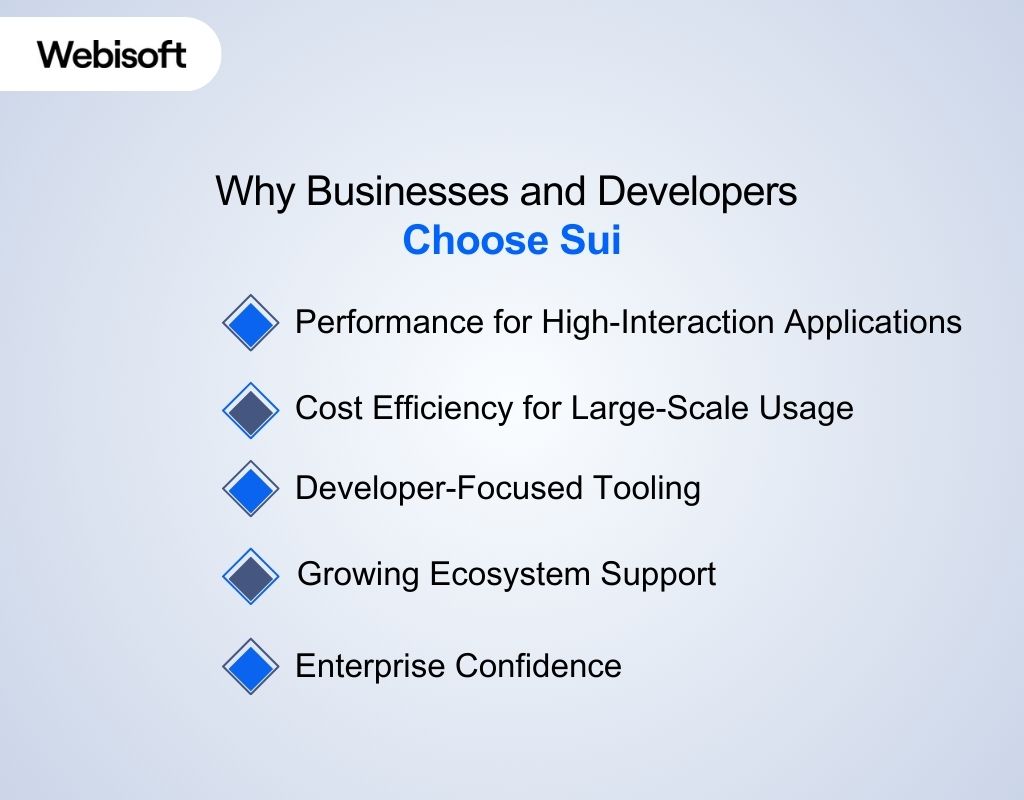 Choosing a blockchain means selecting a foundation for your application’s future. Sui’s architecture, performance, and growing ecosystem offer advantages that appeal to both developers and enterprises.
Choosing a blockchain means selecting a foundation for your application’s future. Sui’s architecture, performance, and growing ecosystem offer advantages that appeal to both developers and enterprises.
Performance for High-Interaction Applications
Sui’s ability to process independent transactions in parallel ensures stable performance even when activity spikes. This behaviour is useful for applications that rely on constant movement, such as live games, marketplaces, and user-driven platforms. You gain an infrastructure that can handle large volumes without slowdowns.
Cost Efficiency for Large-Scale Usage
Predictable fees are important when your application serves many users. Sui separates computation and storage costs, allowing transactions to stay affordable even during increased usage. This stability helps you control long-term expenses while maintaining smooth user experience.
Developer-Focused Tooling
The Move language and Sui’s object-based design simplify the way you structure asset logic. You can define and update assets without layers of defensive code. This reduces development time and lowers the chance of asset-related errors. Sui’s documentation and tooling further streamline your workflow.
Growing Ecosystem Support
The ecosystem includes wallets, marketplaces, DEXs, infrastructure tools, and application frameworks. These components let you integrate essential features rather than building them from scratch. You can accelerate deployment with ready-to-use tools that support scaling, especially when combined with flexible team expansion through Offshore Blockchain Development Services.
Enterprise Confidence
Sui’s roadmap, institutional partnerships, and production-grade infrastructure make it suitable for business environments. The network supports permanent storage, predictable security, and high availability, which are essential for enterprise applications. These traits help you deploy solutions with confidence in long-term platform stability.
How Webisoft Simplifies Sui Blockchain Development
 Developing on Sui requires navigating architecture, smart-contract design, asset modelling, and ecosystem integration. At Webisoft, our expertise translates these technical challenges into streamlined outcomes, letting you focus on building meaningful applications instead of wrestling with infrastructure.
Developing on Sui requires navigating architecture, smart-contract design, asset modelling, and ecosystem integration. At Webisoft, our expertise translates these technical challenges into streamlined outcomes, letting you focus on building meaningful applications instead of wrestling with infrastructure.
Right Architecture From the Start
From your first concept, Webisoft collaborates with you to define tokenomics, asset flows, smart-contract logic, and integration points. We evaluate Sui’s object-centric model, parallel execution, and Move-based contracts, mapping them to your business or product goals. This ensures your architecture takes full advantage of Sui’s strengths, rather than simply replicating patterns from other chains.
High-Quality Move Smart Contracts
Webisoft engineers write, test, and deploy smart contracts on Sui using the Move language and Sui’s native tools. Our team builds your objects, modules, modules upgrades, and permission logic, while applying security best practices, gas optimisation, and workload efficiency.
This means your token or asset system is production-ready from day one, supported by deeper module-level expertise available through Blockchain Protocol Development.
Ecosystem Integration & Wallet-DEX Support
Utilizing Sui’s growing ecosystem, Webisoft handles the work of integrating wallets, DEXs, NFT standards, staking platforms and bridges. We ensure your application connects smoothly with the right wallets, listing frameworks or liquidity pools. You don’t need to become an expert in every external integration, we manage this complexity for you.
Launch, Scale & Maintenance Support
Webisoft supports your deployment from Sui testnet to mainnet, including auditing, monitoring, validator support, and system scaling. We carry out performance testing, upgrade planning, and cost-profiling. As your user base grows, we continue to manage infrastructure, updates, and system health to keep your application running reliably.
Enterprise-Grade Governance and Compliance
If your project addresses enterprise or business use-cases, Webisoft brings governance, regulatory alignment, and security frameworks into your Sui deployment. We design governance, permissions, audit trails, and upgrade flows that meet business requirements while using Sui’s fast execution, stable throughput, and low-latency architecture for dependable performance.
Build powerful Sui applications with Webisoft’s expert team!
Start your Sui project with secure architecture and high-performance development support
Conclusion
Understanding what is Sui gives you a clear picture of how modern blockchain design is shifting toward speed, scalable execution, and flexible asset models. Sui’s architecture shows what’s possible when a network is built for real usage rather than theoretical performance.
As you evaluate where Sui fits into your roadmap, Webisoft can support you with architecture planning, smart-contract development, and ecosystem integration customized to Sui’s strengths. If you want to build on a network designed for the future, our team can help you move forward with confidence.
Frequently Asked Question
Is Sui a fork of another blockchain?
No. Sui is not a fork of any existing chain. It is an independent Layer 1 blockchain created by Mysten Labs using its own architecture, object-based data model, and Move implementation. Everything in Sui’s design was built intentionally from scratch.
Is Move on Sui the same as Move on Aptos?
No. While both platforms use the Move language, their implementations differ. Sui Move is customized for Sui’s object-centric structure, enabling dynamic assets and parallel execution. Aptos uses a more traditional global-state model, which changes how Move modules behave.
Can smart contracts on Sui be upgraded?
Yes. Smart contracts on Sui support controlled upgrades. Developers define upgrade permissions during deployment, allowing modules to remain immutable or to evolve over time. This flexibility helps teams maintain, improve, and secure applications as their requirements change.


